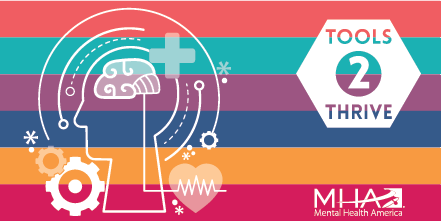Many times bad things happen and we have no control over the situation. We can’t change people’s behaviors or the reality of what is happening, and these experiences are painful. Radical acceptance is a practice that helps us evaluate situations and work to reduce the emotional burden of the reality of the situation like resentment, anger, hatred, or shame. Use this worksheet to help you practice radical acceptance.
This worksheet comes from Mental Health America’s Mental Health Month 2021 Toolkit.
Here’s a web-friendly version of the activity from the worksheet:
What’s bothering you?
Take a minute to write down your thoughts.
Understanding reality
These questions will help you understand the reality of what you are experiencing:
- Look at what you’ve written down. Is there something here that is a reality you have to accept (rather than a judgment or opinion)? For instance: “It shouldn’t be this way” is an opinion. “It is this way” is a reality.
- Think about this reality and just sit with it. For instance: “This is what happened. The past can’t change. It is what it is.”
- What happened? What events led to this reality? (“This is how things happened.”)
Accepting reality
Now it’s time to accept the reality you’ve been fighting against. These questions will help:
- Think about this reality. Can you accept it in your thoughts? What can you tell yourself to help you accept this reality? Imagine what it feels like to accept it.
- Imagine how you’d change your behaviors or actions if you accepted this reality. Imagine how the world would feel if you could let go.
- Think about this reality. Can you accept it in your body? Where are you carrying the resistance to accept this reality? Do you carry that weight in your shoulders or your back? Is there tension or physical pain? Can you practice feeling your emotions in your body and then
practice releasing them from your body? - Do you feel disappointment, sadness, or grief right now? Sit with that. Acknowledge it. Allow yourself to feel these feelings. Understand that it’s ok and expected to feel disappointment, sadness, or grief. Write down anything specific about these thoughts and feelings.
- Despite the pain of this reality, what makes life worth living? Write those things down to remind yourself.
- If you find yourself struggling at this point, write down some pros and cons of accepting or not accepting this reality. Then start back at Step 1 above for your next troubling situation.
Disclaimer: This worksheet is adapted from DBT Skills Training Handouts and Worksheets, Second Edition, by Marsha M. Linehan. Copyright 2015 by Marsha M. Linehan. See page 344 for original
checklist.
"*" indicates required fields
"*" indicates required fields
"*" indicates required fields
"*" indicates required fields

